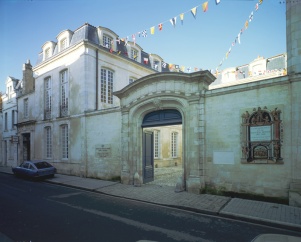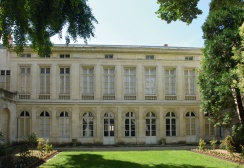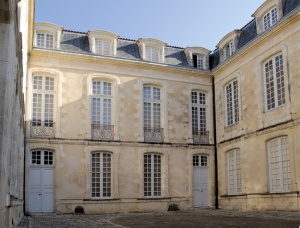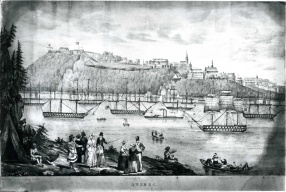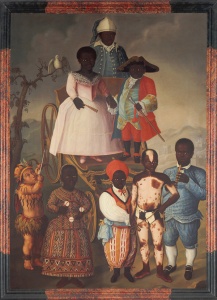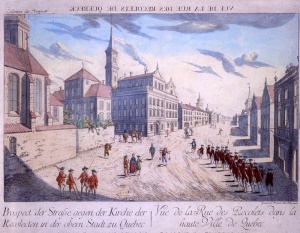Musée du Nouveau Monde, La Rochelle, France
par Martinière, Guy
Housed in a magnificent 18th century private residence, Musée du Nouveau Monde’s collections tell the story of France’s relations with the Americas as conducted from La Rochelle, one of the main ports of New World trade and migration. Paintings, engravings, old maps, sculptures, furniture and decorative art objects conjure up images of Canada, the West Indies, and Brazil as well, with records of the transatlantic slave trade. A section is also devoted to the indigenous peoples of North America and the Far West.
Article disponible en français : Musée du Nouveau Monde de La Rochelle
Hôtel Fleuriau and Musée du Nouveau Monde
La Rochelle’s Musée du Nouveau Monde was inaugurated on May 14, 1982. Hubert Landais, director of French museums outlined its role: “Musée du Nouveau Monde not only has a lovely name, it also has the ambitious goal of representing the relations that France, and La Rochelle in particular, developed with the new worlds so long ignored by the West. Sailors, adventurers, priests, Catholic and Protestant missionaries, scientists, scholars and merchants—most hailing from France’s west coast— joined the rush touched off by the great explorers.”(NOTE 1) Alain Parent, the young curator behind the museum program, put it this way: “Here in the heart of La Rochelle, a new museum is born from memories of a certain America and the acquisition of an 18th century shipowner’s mansion.” (NOTE 2)
The building that houses Musée du Nouveau Monde began its life as a private residence acquired in 1772 by Aimé-Benjamin Fleuriau (1709−1787). His fortune, like so many in Enlightenment-era La Rochelle, was made on the “sugar islands” of the West Indies, especially at the Bellevue plantation on Saint-Domingue (now Haiti). On his return to La Rochelle, Fleuriau purchased the Regnaud de Beaulieu residence, built around 1740, and added a new neoclassical building on the garden side around 1780. The two juxtaposed facades show how architectural tastes changed between 1750 and 1780. The Museum’s main entrance is at 10 Rue Fleuriau, where a monumental gate opens onto a cour d’honneur leading to two the oldest parts of the building, consisting of two avant-corps. The kitchen was here along with a small courtyard, stable and coach house. The master and his family occupied the ground floor living and entertaining quarters, drawing room, dining room and antechamber. A majestic stone stairway with wrought iron banister led to the upper floors which housed studies and bedrooms. The interior detailing, including the original woodwork, has largely been preserved. The rear wing, built around 1780, opens onto a garden twice as large as the main building, facing onto Rue Gargoulleau. The property was acquired by the city of La Rochelle in 1974 under its heritage protection policy and was officially listed as a historic monument in 1978. “All that remained was to give it a purpose and function.” (NOTE 3) The decision was made to convert it into a museum.
Alain Parent’s Museum Project
Alain Parent (1944−1986) oversaw the conversion. In 1978 he presented his idea for a museum of the New World to the mayor of La Rochelle, Michel Crépeau (1930−1999). Over the course of the preceding decade, Parent had acquired extensive knowledge of the art of the Americas, notably during a stint at Montreal’s Museum of Fine Arts. He was even consulted as an expert by the National Museums of Canada. His La Rochelle museum project aimed to boldly combine the work of contemporary artists from Canada and the U.S. with themed displays on New World history and society. This meant mixing contemporary art—enjoying an upsurge in France thanks to the “Beaubourg effect”—with the history of French America, and commemorating the instrumental role played by the port city of La Rochelle in spearheading France’s international endeavours.
Over three years Hôtel Fleuriau was restored and transformed into 1,000 m2 of museum space with 19 public exhibition halls. Alain Parent spent these years assembling the original collections with the help of his Canadian and North American contacts. David Stewart (1920−1984), president of the Macdonald Stewart foundation, was one of the most important donors. Starting in 1979—before the museum was even officially inaugurated—several major exhibitions were held. Some fine examples of Parent’s curatorial direction are “Mémoire d’une Amérique,” 1980; “Autre Amérique,” 1982; and “Mémoire d’un port: La Rochelle et l’Atlantique XVIe-XIXe siècle,” 1985 (NOTE 4).
Meanwhile, in 1984 Parent curated “La Renaissance et le Nouveau Monde” at Musée du Québec, a major commemoration of the 450th anniversary of Jacques Cartier’s 1534 landing (NOTE 5). This perspective on Quebec and Canada was further explored in La Rochelle in 1992 on the occasion of the 500th anniversary of Columbus’s 1492 voyage by Parent’s successor, Thierry Lefrancois, who put together an exhibition on the fur trade entitled “La traite des fourrures: Les Français et la découverte de l’Amérique du Nord” with the participation of Canadian historians Pauline Arseneault, François Trudel and Thomas Wien (NOTE 6).
From North America to Latin America
For Alain Parent, representations of Quebec, Acadia, Louisiana, the Great Lakes, the Mississippi, and the fur trade and North America’s indigenous peoples were by no means the only aspects of the New World worthy of the museum’s attention. The West Indies, including Saint Domingue (Haiti), known as “Sugar Island” also loomed large in the collective memory of La Rochelle. And this New World extended to Latin America: indeed, in October 1986, Parent had curated the inaugural Casa França-Brasil exhibition in Rio de Janeiro exploring France−Brazil relations. When Parent died suddenly in July 1986 he was in the process of expanding the museum’s South American holdings. This new interest is evident in one of the museums most spectacular acquisitions: José Conrado Roza’s 1778 “Wedding Mascarade,” a painting of the Portuguese school, placed in a prime location: the alcove of what had been the bedroom of generations of Counts de Fleuriau (NOTE 7).
Today, Musée du Nouveau Monde houses a remarkable permanent collection bringing together representations of the Americas as it was perceived in the collective imagination of a French Atlantic port city whose destiny was tied with that of the New World. One exhibition room is devoted entirely to Canada, where visitors can see a variety of depictions of aboriginal people—18th century watercolours of a Mohawk warrior and squaw, Joseph Charles Marin’s (1759−1834) terra cotta work “Canadian Indians at Their Infant’s Grave,” a multicoloured sculpted Indian mask from the 19th century, a Bacquin lithograph depicting the fur trade. Quebec landscapes are also on display: highlights include François Haberman’s (1721−1796) “La rue des Récollets” (c. 1760), “Montmorency Falls” by Georges Heriot (1759−1839), and a view of the warship Hastings arriving at Quebec City with Count Durham, Governor General of Canada, May 28, 1838—a lithograph by Day and Haghe, after Captain Digby B. Morton’s drawing.
In its thirty-odd years, the museum has presented some seventy temporary exhibitions bringing together historical artefacts and contemporary art and showcasing the diversity of representations of the Americas (NOTE 8). The museum seeks to innovate with images that challenge our temporal and spatial conceptions of the vast continent that is the Americas.
Guy Martinière
Professor Emeritus, Université de La Rochelle.
NOTES
1. Exhibition catalogue: “Une autre Amérique,” p.9. La Rochelle: Musée du Nouveau Monde, 1982.
3. Robert Kalbach, Deputy mayor in charge of cultural affairs, idem, p.11.
4. Alain Parent: Mémoire d’une Amérique. La Rochelle: Musée du Nouveau Monde, 1980. Une autre Amérique. La Rochelle: Musée du Nouveau Monde, 1982. Mémoire d’un port. La Rochelle et l’Atlantique XVIe-XIXe siècle. La Rochelle: Musée du Nouveau Monde, 1985.
5. La Renaissance et le Nouveau Monde. Quebec City: Gouvernement du Québec, 1984.
6. Thierry Lefrançois, La traite de la fourrure. Les Français et la découverte de l’Amérique du Nord. La Rochelle: Musée du Nouveau Monde, 1992.
7. Thierry Lefrançois: Musée du Nouveau Monde. Manuel du visiteur et de l’amateur. La Rochelle: Musée d’Art et d’Histoire, 1990.
8. Guy Martinière, “Les représentations des Amériques à travers les expositions du Musée du Nouveau Monde de La Rochelle,” p.319-332, in Philippe Joutard, Thomas Wien and Didier Poton (eds.): Mémoires de Nouvelle-France. De France en Nouvelle-France. Rennes: PUR, 2005.
BIBLIOGRAPHY
Alain Parent : Mémoire d’une Amérique, La Rochelle, Musée du Nouveau Monde, 1980, 128 p. ; Une autre Amérique, La Rochelle, Musée du Nouveau Monde, 1982, 261p. ; Mémoire d’un port. La Rochelle et l’Atlantique XVIe-XIXe siècle, La Rochelle, Musée du Nouveau Monde, 1985, 144p.
La Renaissance et le Nouveau Monde, Québec, Gouvernement du Québec, 1984, 346 p.
Thierry Lefrançois : La traite de la fourrure. Les Français et la découverte de l’Amérique du Nord, La Rochelle, Musée du Nouveau Monde, 1992, 172 p.
Thierry Lefrançois : Musée du Nouveau Monde. Manuel du visiteur et de l’amateur, La Rochelle, Musée d’Art et d’Histoire, 1990, 127 p.
Guy Martinière : « Les représentations des Amériques à travers les expositions du Musée du Nouveau Monde de La Rochelle », p.319-332, in Philippe Joutard et Thomas Wien avec la collaboration de Didier Poton (sous la direction de) : Mémoires de Nouvelle-France. De France en Nouvelle-France, Rennes, PUR, 2005, 390 p.
Additional DocumentsSome documents require an additional plugin to be consulted
Images
-
 Cornélius Krieghoff,
Cornélius Krieghoff,
Traineau tiré p... -
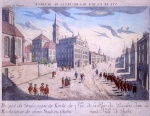 François Haberman, La
François Haberman, La
rue des Récoll... -
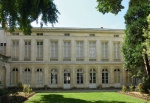 Hôtel Fleuriau : faç
Hôtel Fleuriau : faç
ade néo-classiq... -
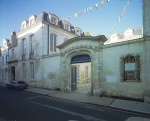 Hôtel Fleuriau : le
Hôtel Fleuriau : le
portail, la cou...
-
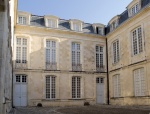 Hôtel Fleuriau : cour
Hôtel Fleuriau : cour
principale -
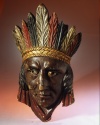 Masque d’indien sculp
Masque d’indien sculp
té et polychrom... -
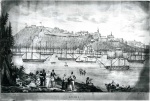 Québec lors de l'arr
Québec lors de l'arr
ivée du vaissea...

